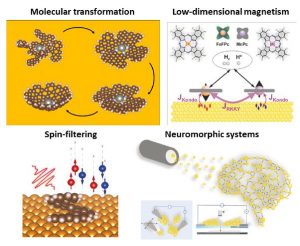This century’s rapid improvement in scaling down Si-based devices in order to improve cost and performance has enabled some of the greatest achievements of mankind. However, this approach is coming to its utmost limits posed by reaching dimensions where quantum size effects emerge. In order to overcome this limitation and enable future sustainability, novel avenues like the bottom-up approach are needed – rather than scaling down the device size, it promotes the idea to engineer them from smaller fragments. As such it relies on detailed understanding of interaction between atoms, molecules or their larger assemblies. The use of well-defined model systems comprising of nanomaterials on surfaces can provide insight into the individual steps of more complex processes that are of importance for further engineering of materials. Atomic and molecular systems at surfaces provide the particular advantage of addressability to study their properties with an arsenal of advanced spectroscopic and microscopic surface analytic techniques.
In this seminar, I will present a couple of examples where surface-supported nanomaterials were studied using combined spectro-microscopy approach of lab and synchrotron based techniques. I will demonstrate how the combination of these techniques can be used to better understand molecular transformation through covalent C-C coupling reactions or interaction of hydrogen with metal-containing phthalocyanine macrocycles but also how intermolecular interactions can lead to the formation of topological systems exhibiting two-dimensional magnetism, whether chiral molecules can act as spin filters or how the switching behaviour similar to one in our brains appears in the ensembles of metallic nanoclusters.

Swansea University, United Kingdom




